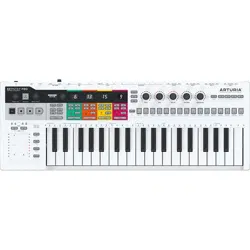Loading ...
Loading ...
Loading ...

5.3.3. Editing Steps
We've already explained the basics of step-editing in
Chapter 3 [p.13], but there's much more
to learn and discover.
In several ways, the KeyStep Pro sequencer is more advanced than a traditional step
sequencer. One advanced feature is that it lets you transpose the sequence simply by
playing keys on the keyboard. Most early step sequencers could not do this; instead,
the pitch of each note was set with a knob or slider. More importantly, the KeyStep Pro
sequencer lets you edit all parameters of the note or notes stored in a step.
5.3.3.1. Step Edit Mode
Enter Step Edit mode by pressing the Step Edit button, which is probably one of the most
important buttons on the KeyStep Pro. You use it to edit the steps of the currently selected
sequence individually.
When the sequencer is stopped and Step Edit is ON, pressing a step button selects that step.
Play a note or a chord (a stack of notes) to store in that step, or if the step already contains
a note or a chord, change it using the keyboard. The note or chord you press will replace
the existing note(s).
When you enter step editing mode, you have two options: you can edit all the notes stored
in a step simultaneously or edit the notes in the step individually.
In Step Edit mode, the keyboard turns into a traditional step editor. When a step is active (its
button is blinking), you can edit all of its parameters: for example, turning the Pitch encoder
will lower or raise the pitch of the note or notes stored in that step; turning the Gate encoder
will shorten or lengthen the gate time of the note or notes stored in that step.
To edit the values of all the notes simultaneously:
• Turn the Pitch encoder to move all the notes in the selected step up or down on
the currently selected scale
• Turn the Gate encoder to lengthen or shorten the gates of all the notes in the
selected step.
• Turn the Velocity encoder to change the velocity of all the notes in the selected
step.
• Turn the Time Shift encoder to move all the notes in the selected step forward or
backward in time
• Turn the Randomness encoder to change the probability that the chord stored in
this step will sound.
Arturia - User Manual Keystep Pro - Making Tracks 83
Loading ...
Loading ...
Loading ...
